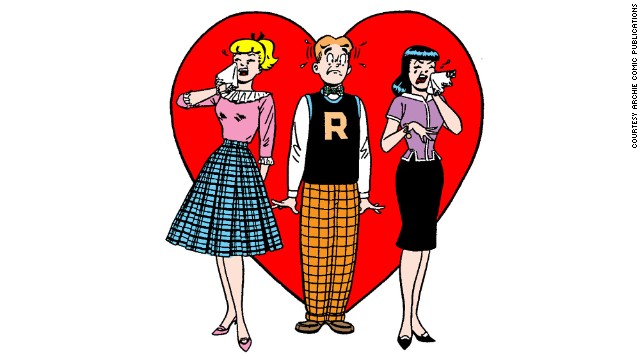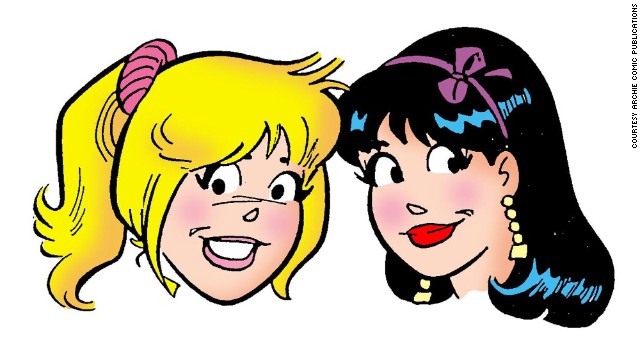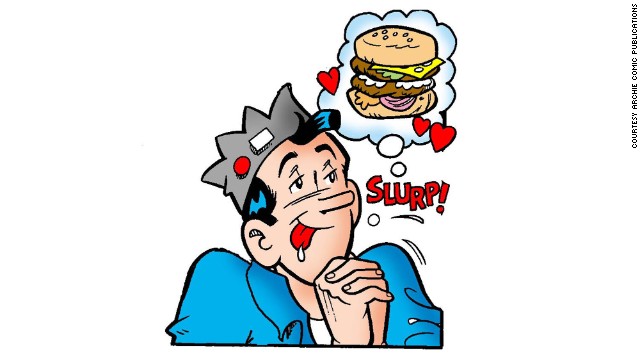
STORY HIGHLIGHTS
- Bob Greene: Victor Gorelick has stayed with the Archie comic for 55 years
- Greene: Gorelick was enchanted with the gentle simplicity of the problems Archie faced
- He says while the world is complex and ugly, the world of Archie – Riverdale – is appealing
- Greene: Archie, with his perpetual smile, is like a best friend for Gorelick
Editor’s note: CNN Contributor Bob Greene is a best-selling author whose 25 books include “Late Edition: A Love Story”; “When We Get to Surf City: A Journey Through America in Pursuit of Rock and Roll, Friendship, and Dreams”; and “Once Upon a Town: The Miracle of the North Platte Canteen.”
(CNN) — If a fellow is going to spend 55 years working in the same place, he would be wise to count his blessings that the place is Riverdale.
“The first day I walked in, in 1958, I was 17 years old,” said Victor Gorelick. “I took a job as a fill-in art assistant.”
He never went on to college. He never took another job. Today he is 72. His explanation for staying is so basic he can express it in a single sentence:

Bob Greene
“I decided to stick with Archie.”
And Betty. And Veronica. And Jughead. And Reggie. And, most of all, Riverdale, U.S.A.
It doesn’t exist, of course, which is probably what makes the town so perfect. Nothing in real life could match it. Archie Andrews first appeared in a comic book in 1941, and that idealized town in which he and his friends have always lived has never been identified by state. Some readers assume it is in the Midwest, but Gorelick — the longest-serving employee of Archie Comics, and now its editor-in-chief — will go no further than to say that “it’s in a place that has four seasons.”
The summer, autumn, winter and spring in the pages of the comic books have never been the same seasons that Gorelick has observed outside the windows of the Archie offices in Westchester County, New York: “We have a four-month lead time. So the season an artist is drawing on a given day is not the same season we’re living in actual life.”
But actual life is not the key to Archie’s eternal appeal, which may have a lot to do with what attracted Gorelick to the character, and the company, in the first place. He grew up in Brooklyn, an only child until he was 16: “My father worked in a fish market. He’d leave the house at 4:30 or 5 o’clock in the morning, he would clean fish and sell fish all day, and he would come home tired with fish scales and sawdust on his shoes. I would clean his shoes. He worked so hard for his money. He never took me fishing.”
Archie Andrews’ world, mythical though it was, had to have looked pretty swell next to that. When Gorelick, with Dwight D. Eisenhower in the White House, showed up for that fill-in job in the art department, his own comic-book tastes had tended toward “Tales from the Crypt.”
But he soon became enchanted with the gentle simplicity of the problems Archie faced: “He’s this klutzy, well-meaning kid who breaks things by mistake in Veronica’s house, or who cooks a beautiful breakfast to bring upstairs to his mother on Mother’s Day, but leaves behind a mess in the kitchen.”
Gorelick’s real life may or may not be any more irritation-free than anyone else’s — on the day we spoke he was battling a nagging cough that wouldn’t let go — but there is something to be said for being able, for all these years, to lose himself, professionally, in a comic-book world where matters are ever placid, ever sunny.
He has even been able to derive inspiration from the characters who live on those pages; Archie takes solace in having a close buddy, Jughead Jones, “who he can talk to and tell him anything.” Gorelick said he has come to realize that his own Jughead Jones, his port in a storm, “lives in New Jersey. His name is Bert Bailin. I’ve known him for 65 years, since we were kids. He was my best man — twice.”
Ten presidents have succeeded Eisenhower during Gorelick’s years with Archie, and the country has changed in myriad ways. Some of those changes have been reflected in the storylines of the comics — racial and ethnic diversity in Riverdale, the introduction of a popular gay character — and others have manifested themselves in the delivery systems for those stories: the disappearance around the nation of mom-and-pop candy stores with comic-book racks (although Pop Tate’s Sweet Shop remains a vibrant Archie landmark), the rise in digital readership and availability of Archie apps. The Archie comic books continue to publish with new stories, in various sizes and lengths; no new Archie newspaper strips are being drawn, although reruns of the old ones are available digitally.
Yet what is constant in that make-believe town is more significant than what is altered, Gorelick said: “Behind everything is the idea that Riverdale is a place that is welcoming to anyone. The goal has always been to be a place of comfort to our readers, especially for our youngest readers.” Nothing terrible or violent happens in Riverdale: “You have to keep that out of our town. Kids today go through metal detectors at their schools, there are police officers in the hallways, the drugs, the gangs.” By design, “Archie lives in a world the way we might like it to be.”
Gorelick understands how elusive such a world is. When he switches on his computer at work, the ugliness of news headlines on the screen reminds him that none of us really lives in Riverdale. Even in the corporate offices of Archie Comics there has been acrimony in recent years, with lawsuits and bitterness between two top officers. But in the editorial department, Gorelick’s job is to keep his focus on pretend streets where nothing becomes much more complicated than “Archie getting a little bamboozled because he has made a date with two different girls on the same night, and he asks Jughead, ‘How did I get into this mess?’”
After all this time, does Archie seem real to him — even like a friend? “He’s my best friend — he’s paid me every week for 55 years.” Does he think about Archie after he’s closed his office door for the night? “Constantly. I’ve got a framed oil portrait of him in my den at home.” Does Archie’s perpetual smiling youth ever make him consider his own mortality? “I know I’m not going to be around forever. Archie goes on.”
Follow us on Twitter @CNNOpinion.
Join us on Facebook/CNNOpinion.
The opinions expressed in this commentary are solely those of Bob Greene.
This article is from:
The post Why we still love Archie appeared first on Arne Ruhnau News.
via Arne Ruhnau News http://arneruhnau.com/why-we-still-love-archie/
 Archie Andrews, eternal teenager, is the central character in a comic that kicked off in 1942 and was set in the mythical Riverdale, where nothing too upsetting happens. Fans have followed along since then as Archie and his Riverdale High friends, including two best gal pals, Veronica, left, and Betty — shown here in the 1990s — get into wacky adventures, share sodas and even evolve with the times somewhat (the strip added racial diversity and a gay character in a recent years).
Archie Andrews, eternal teenager, is the central character in a comic that kicked off in 1942 and was set in the mythical Riverdale, where nothing too upsetting happens. Fans have followed along since then as Archie and his Riverdale High friends, including two best gal pals, Veronica, left, and Betty — shown here in the 1990s — get into wacky adventures, share sodas and even evolve with the times somewhat (the strip added racial diversity and a gay character in a recent years).  Of course, things could get tense, even in Riverdale, as Archie bumbled through his love troubles with the kind blonde next door, Betty Cooper, who couldn’t catch a break against the dark-haired rich girl, Veronica Lodge. Archie’s letter sweater and the girls’ retro skirts in this ’60s-era version would soon give way to more groovy looks — with Betty and Veronica sporting tight pants and miniskirts.
Of course, things could get tense, even in Riverdale, as Archie bumbled through his love troubles with the kind blonde next door, Betty Cooper, who couldn’t catch a break against the dark-haired rich girl, Veronica Lodge. Archie’s letter sweater and the girls’ retro skirts in this ’60s-era version would soon give way to more groovy looks — with Betty and Veronica sporting tight pants and miniskirts.  Betty, a nice, smart girl with the hots for Archie, and Veronica, a wealthy, conceited teen who will happily throw Archie aside when a hunkier guy comes along are, improbably, best friends anyway. Over the years the two have been drawn as fashion plates who change with the times — from swing skirts to hot pants to preppie duds. But their rivalry over Archie is unchanging.
Betty, a nice, smart girl with the hots for Archie, and Veronica, a wealthy, conceited teen who will happily throw Archie aside when a hunkier guy comes along are, improbably, best friends anyway. Over the years the two have been drawn as fashion plates who change with the times — from swing skirts to hot pants to preppie duds. But their rivalry over Archie is unchanging.  Jughead Jones is Archie’s best friend and partner in tomfoolery, a slug of a guy whose character is built mainly around his voracious consumption of food. He’s not the ladies’ man that Archie tries to be, but he loves his big dog Hot Dog, likes to draw, is surprisingly smart and in later comics takes up skateboarding and video games.
Jughead Jones is Archie’s best friend and partner in tomfoolery, a slug of a guy whose character is built mainly around his voracious consumption of food. He’s not the ladies’ man that Archie tries to be, but he loves his big dog Hot Dog, likes to draw, is surprisingly smart and in later comics takes up skateboarding and video games. 



No comments:
Post a Comment